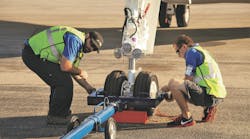The electric arc and safety hazards caused by improper aircraft grounding can be prevented.
Have you experienced an electric arc when you attach or disconnect a ground lead from an aircraft-grounding stud? Is it dangerous or just a nuisance? Arcing should be avoided but it happens to be a common experience in the aircraft maintenance and refueling.
Grounding of a parked aircraft is a standard practice, although more prevalent in a hangar than on a terminal ramp. When aircraft are parked at the gate, except when they are fueling, it is common practice to leave the aircraft ungrounded. In a hangar or a production plant proper grounding is the rule.
Cause and effect
Most 400Hz installations, as a safety measure, are designed with a grounded neutral at the 400Hz source. This practice is used because it grounds the skin of the aircraft and it is a good safety measure. Most aircraft do not have balanced loads and are designed with numerous single-phase loads. Single-phase loads will cause a current in the neutral conductor. Most hangar facilities have several grounds, 60Hz (or 50Hz), 400Hz, and a static grid. They may or may not be common. When a mechanic grounds the aircraft, usually with a static connection from a floor-grounding grid, this is where the problem can occur. Because the 400Hz neutral is also grounded and carrying current the new static ground path shares the neutral current, thus an arc is drawn whenever you connect or disconnect this ground lead. It is difficult to say what percentage of neutral current is shared, but since the ground lead is smaller and has a higher resistance, it usually draws less current but current nonetheless. Hence we have the dreaded arc, considered a hazard by any safety committees and surely a perceived hazard by most.
Contributing to this problem is the possibility that the static ground could carry all of the neutral current if the neutral is lost in the aircraft cable connection. In addition to arcing, the static ground wire can carry enough current to glow, red-hot. This problem can also be present in mobile equipment if the equipment is powered by the utility and uses the same grounding techniques as a fixed system. If you apply a static ground to a mobile engine-generator set then again the same rules apply.
What can you do?
The real question is how do you handle this grounding dilemma? Static grounding of an aircraft is essential especially during fueling and solid grounding of the 400Hz equipment, which is equally important. Implementing a procedure by which a static ground is connected or disconnected only when the 400Hz power is off will prevent an arc, but would be tough to implement and certainly does not account for human error. Like so many engineering problems there is more than one solution.
A first step is to insist that your 400Hz equipment supplier build equipment that has an isolated neutral with the ability to ground it or not. If it is grounded, it should only be grounded at the source and not at every aircraft position to avoid ground loops.
The NEC says that the neutral on the secondary of a transformer must be grounded. Boeing has such strong feelings of not grounding that transformer that they solicited the NEC to allow it to be ungrounded.
So Where are we now and what is the purpose of this article?
Here are some ideas:
- Investigate the static grounding system to see if it is in place and utilized.
- Investigate the 400Hz system to see how often neutral is grounded in the system. It should be grounded once to avoid ground loops and multiple paths.
- See if your converter (rotary or static) has an isolated neutral or single point ground. This system information allows you to contact your system integrator with this knowledge. Most are able to solve that problem.
By all means the neutral grounding issue should be considered for new construction as there is no cost impact and you have the satisfaction of knowing you have a safe grounding system.
Patrick O'Brien is president and CEO of MCM Engineering, a Burlingame, CA company he formed in 1991.





